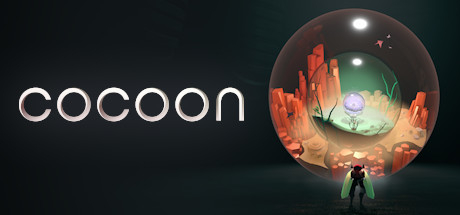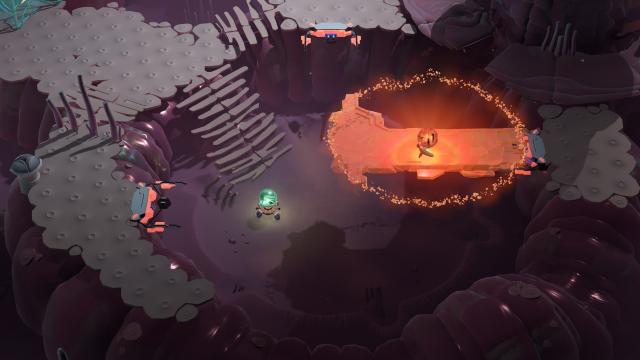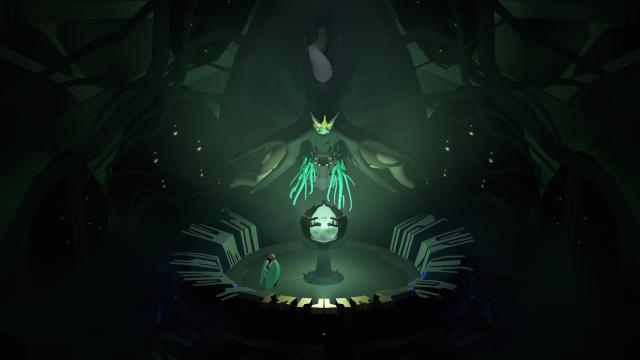Existing User Log In
New User Registration
Register for a free account to gain full access to the VGChartz Network and join our thriving community.





America - Front


America - Back

Geometric Interactive
Adventure
 (Add Date)
(Add Date) (Add Date)
(Add Date) (Add Date)
(Add Date)
| Owners: | 0 |
| Favorite: | 0 |
| Tracked: | 0 |
| Wishlist: | 0 |
| Now Playing: | 0 |
Upon seeing its reveal trailer for the first time, the immediate connection I made with Cocoon was – oddly enough – Men in Black's ending. In it, you see that the universe is encased in a marble that an alien was playing with. That shot still leaves an impression on me decades later. It's a fitting comparison in the modern gaming world as well. For all the pageantry around an open world's scope measured by square kilometers, Geometric Interactive captures a more intriguing and memorable sensation: holding an immense world upon your shoulders. The ways in which this freshmen team built upon that inspired concept is what earns it such high esteem.
These portals into strange new lands informs everything else. As this bipedal insectoid protagonist, it doesn't take long discovering these marble worlds by – funnily enough – gracefully leaping out of one yourself. The arid, orange desert you started in before is now held within a transparent shell. You're lured to pluck this foreign object and place it between this beetle's wings; soon thereafter, another location houses what's essentially an altar for this orb. Once set down, the darkened puddle surrounding this pedestal strums to life with a larger portrait of what's within this magic marble. After holding the interact button, you do a majestic spinning dive back into the sphere and traverse its landscape again. There's something to be said for Geometric's sedulous dedication to these silky-smooth animations and seamlessly entering/exiting these worlds without loading screens.
Game design is a story of addition by subtraction. The color-coded orbs – between the aforementioned orange, white, etc. – are more than just worlds to plonk into the correct plug-in. Each one doubles as a portable dungeon and what's essentially a dungeon item; that can mean acting as the ignition key for an alien craft or utilizing that colored orb's specific trait, such as materializing new platforms. Hell, the only necessary inputs throughout the entire game are either pressing or temporarily holding the A button; yet, how those inputs are utilized makes so many actions feel slightly different. Every element has been squeezed down to its necessary components, which in turn multiplies its impact.
By compounding dual uses for each orb, you're also looking ahead in a different way. These miniature worlds feel so meticulously crafted because you're weighing quandaries both within and outside of the space simultaneously. Think of these glass spheres like Russian nesting dolls that can magically shrink or expand at a moment's notice. All it takes is hoisting one on your back, jumping into another orb-world, setting your carried orb on a nearby node, and bob's your uncle. You're placing worlds within worlds. The initial gimmick will be about transporting multiple orbs at once, but it eventually evolves into Inception-esque brainteasers, considering ripple effects further and further down the rabbit hole. Now you're thinking with marbles!
As the orbs grow in number and that vertical chain gets potentially longer, some later segments can feel too protracted for their own good; after all, mentally working out solutions in a multi-sequence puzzle tends to stretch the time. Those elaborate conundrums tend to inflate the amount of necessary walking, especially when rectifying a mistake, but at least the extra steps feel worth it. Much of Jeppe Carlsen & co.'s dynamism in puzzle design carries straight over from their Playdead years: the steady churn of new ideas and succinctly communicating so much without a spoken word. Such acuity in design seen through merely a control stick and interact button is downright remarkable. 
Such simplicity does bear a certain drawback with regards to difficulty. While some of the physical demands will be a bit belabored, especially when you're mentally a few steps ahead, the countervailing sensation to later sections is a buildup akin to going over speedbumps; most of the time, you're only meant to be encumbered to a point instead of utterly confounded. There's a most-ages appeal which may not hit the consistent highs of other puzzlers, but nevertheless does enough to lull you into a flow state. When considered with this team's pedigree, it's about balancing the challenges while soaking in these worlds as though it's a continuous odyssey.
Also similar to Playdead's LIMBO and INSIDE, a hushed approach to storytelling goes a long way in showcasing a world of subdued callousness. You're sojourning through mostly-empty worlds, with the occasional boss fight, yet there are bountiful pockets of organic and mechanical life – sometimes a combination of both – contained within each orb. There isn't a concrete explanation as to why every boss introduces itself before descending into a color-coded marble, nor the telekinetic control of an insect via a fleshy vine; and yet, this subtle crossover into Cronenberg feels natural. You will summon creatures whose sole purpose is creating new pathways, and soar past interconnected blobs seemingly powering the place (but how?), yet it's so easy to drink everything in and forget to ask questions.
It's all the easier to imbibe these alien worlds with such sumptuous presentation too. I know, there are always one or two yearly indie games that capture the Hot Indie Game™ aesthetic to a tee – the types that'll stop gamers in their tracks at road shows and exhibitions. Cocoon's greatest visual strength isn't merely good lighting or good color schemes, but rather how every sequence is framed. The scaled-back isometric viewpoint tied with Jakob Schmid's euphonious – if not all that memorable – soundtrack creates so many great perspective-altering moments. Hell, I'm spoiled for choice when selecting screenshots since every frame is genuinely a painting. 
Nestled within both the team's past history and its puzzle design is the presumption of Cocoon not being an expansive puzzle-platformer; indeed, the modest 4.5-hour runtime (plus a bit extra for 100% Achievements/Trophies) for $24.99 feels… content-trimmed in light of other puzzlers from this year. But that wouldn’t give an appropriate picture as to why that's the case. The best explanation for its sustained forward momentum is how its design prevents excessive backtracking: floating platforms go one way, stairs or ramps that become walled off, and so on. That beneficent attitude makes sense for juggling multiple marbles too. Beyond maintaining a good tempo, Geometric is also invested in presenting so many creative ideas once. Sure, there are the aforementioned animations when entering/exiting a world, a repeating pattern-match brainteaser, and some perfunctory shooting segments, but they're a mere puddle to the sea of special one-off designs littered throughout.
The allure of capturing a "Playdead-esque" appeal by imitators (Stela) or former employees now with their own studio (Somerville) is a fad that crops up now and again. Geometric Interactive's tightly-knit history suggested it'd take a similar path too, but despite sharing connective tissue – especially in its Indie Game™ presentation – the subtle shifts away from the past result in something more vibrant and memorable. It's not merely felt from a different camera perspective, but in how the recursive worlds-within-worlds concept breathes unique life into so many of your interactions as well. To manage this while sustaining such imagination ranks Cocoon among my favorite puzzle adventures of recent memory.
Contractor by trade and writer by hobby, Lee's obnoxious criticisms have found a way to be featured across several gaming sites: N4G, VGChartz, Gaming Nexus, DarkStation, and TechRaptor! He started gaming in the mid-90s and has had the privilege in playing many games across a plethora of platforms. Reader warning: each click given to his articles only helps to inflate his Texas-sized ego. Proceed with caution.









